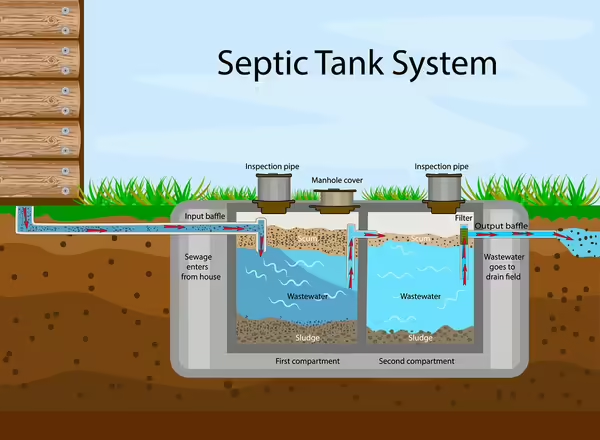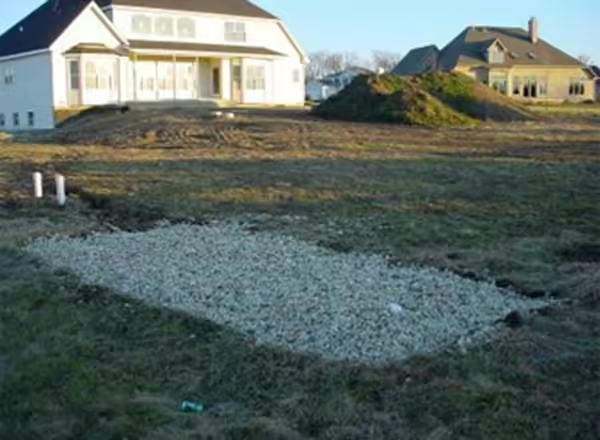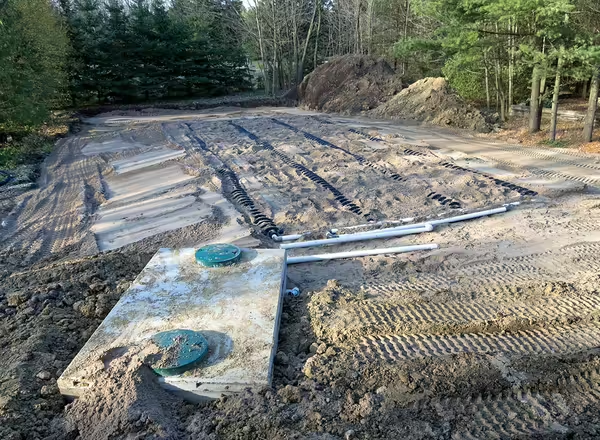Household wastewater flows from drain pipes in the house to an outside drain line that empties into a large tank called a septic tank. As wastewater comes into the tank it is slowed by a baffle. The tank is always full of wastewater, to the level of the outlet pipes. The tank is meant to hold the water for up to 24 hours. This allows solids to separate and settle out. These solids will partially decompose over time, but not completely. Over time, a layer of solids (called sludge) slowly builds up in the bottom of the tank. A grease layer (called scum) also builds up on top of wastewater.
With little to no oxygen present in the tank, bacteria that function in the absence of oxygen partially decompose organic materials present. Called anaerobic bacteria, they also produce gases that can be harmful or fatal to humans in large concentrations.
At the outlet end of the tank, another baffle is present to prevent scum from entering the drain lines. Partially treated wastewater, (called effluent) flows out of the tank into a line or multiple lines made up usually of plastic pipe with small perforations. The effluent is evenly distributed throughout this drainage field. As the liquid moves into the soil, bacteria in the soil complete the treatment process, removing impurities and pathogens.

The basic setup for this type of system includes an aeration tank, air supply system, final treatment chamber, and discharge. Several additional components may be added to the system, such as a trash tank used to remove materials that will not be decomposed in the aeration tank.
As wastewater flows into the aeration tank, microbes that function in the presence of oxygen work to decompose waste material. Oxygen is supplied by the air supply system. In some systems, small plastic balls are employed. These plastic pieces allow microbes to grow on their surfaces, and will move freely through the aeration tank.
From the aeration tank, wastewater then goes through a final treatment. This typically involves disinfection, through chlorination. Tablet chlorinators contain tubes that supply the tablets to a contact chamber, where the wastewater is disinfected. Other potential disinfection processes use ultraviolet light or ozone. Treated water then moves into an underground drainage field, or will be surface discharged (see section on Surface Discharging Systems for EPA regulations on these systems).
In some areas, a traditional drainage field is not feasible, or additional treatment of wastewater is required. In situations where the drain field may be at a higher elevation than the primary treatment area, it the system will use a pump to move the effluent to the drainage location.

These are for evaporation and transpiration of treated effluent, and usually follow aerobic treatment units or sand filters. As the water is lost, salts and other minerals will slowly accumulate in the bed. These are used where there is heavy clay soil or shallow rock present, and like surface discharge systems, have restrictions.

Sand or gravel filters provide additional treatment as part of a drain field. Effluent is moved to the top of a bed of sand or fine gravel. The liquid at the bottom of the bed then moves to a drain field, or may be recirculated before moving to the drain field. Besides sand, foam or peat may be used.

A mound system is used in high water table or other soil limiting conditions. Effluent is pumped to a mound of sandy material that is covered with topsoil and grass. Wastewater slowly moves through the sand, and is treated by naturally occurring microbes. Evaporation and transpiration helps to remove water from the system.
Raised Filter Beds
These are similar to mounds, but usually require a batch treatment tank, that provides additional wastewater treatment prior to being moved to the filter bed. The wastewater is moved into the batch tank in doses and works to remove additional solids and pathogens. It is then moved to the raised bed, where final treatment occurs.